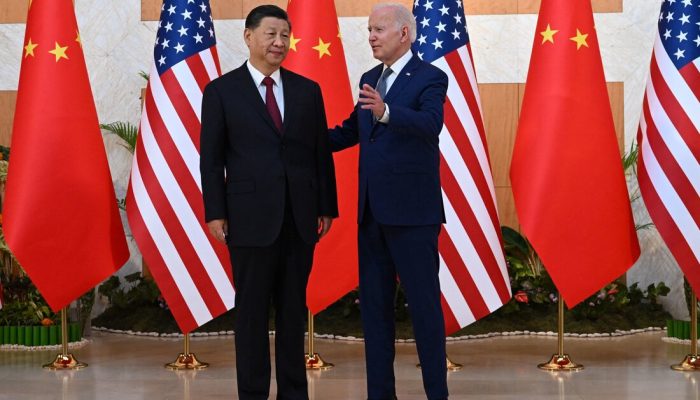The meeting between Chinese President Xi Jinping and outgoing U.S. President Joe Biden in Lima, Peru, at the Asia-Pacific Economic Cooperation (APEC) forum, encapsulated the fraught dynamics of Sino-American relations. With the incoming administration of Donald Trump poised to reshape U.S. foreign policy, Xi’s remarks underscored China’s intent to stabilise ties, even as unresolved tensions loomed large.

A Diplomatic Balancing Act:
Xi Jinping’s statement about maintaining a “stable, healthy, and sustainable China-U.S. relationship” reflects Beijing’s recognition of the stakes. The transition of power in the U.S. has historically been a sensitive period, marked by heightened risks of miscommunication and conflict. Xi’s outreach to the Trump administration was a formal and calculated attempt to manage the bilateral relationship during this uncertain phase. He acknowledged the “ups and downs” in U.S.-China relations, emphasising the need to communicate, cooperate, and manage differences.
Biden, representing a more moderate stance, echoed the importance of candid dialogue. While there were no breakthroughs on contentious issues, the two leaders agreed on the critical principle that decisions regarding nuclear weapons must be left to humans, not artificial intelligence. Though narrow in scope, this shared commitment signals the potential for common ground even amidst broader disputes.
Key Points of Contention:
Despite Xi’s overtures, the meeting highlighted the persistent divisions between the world’s two largest economies. The Biden administration raised several critical issues:
- Taiwan Tensions: The U.S. voiced concerns about China’s “destabilising” military activities around Taiwan. Xi, in turn, reiterated China’s stance against Taiwan’s independence, framing it as incompatible with regional peace. Taiwan, with its strategic importance and democratic governance, remains a flashpoint, as Beijing views the island as part of its territory, while the U.S. continues to provide arms and support.
- Cybersecurity Concerns: A recent hack targeting U.S. government officials, allegedly linked to China, added another layer of tension. Xi dismissed the accusations, but the incident underscores the growing prevalence of cyber conflict as a dimension of international rivalry.
- South China Sea Disputes: Biden reiterated U.S. opposition to Beijing’s maritime claims in the South China Sea, which international courts have rejected. Xi warned against U.S. involvement in disputes like the Spratly Islands, reflecting China’s broader resistance to American influence in the region.
- Economic Friction: The Trump administration’s trade policies, including proposed tariffs and export restrictions on sensitive technologies like artificial intelligence and semiconductors, loomed over the talks. Biden defended these measures as essential for U.S. national security, while Beijing argued they were unjustified.
Broader Geopolitical Dynamics:
The meeting also touched on global challenges where U.S. and Chinese interests intersect yet diverge:
North Korea’s Role: The deployment of North Korean troops in support of Russia’s war in Ukraine sparked U.S. criticism, with Biden urging China to leverage its influence to prevent further escalation. While Beijing officially opposes the war’s expansion, its actions have often been ambiguous, reflecting its balancing act between Russia and Western powers.
Russia and Ukraine: China’s close ties with Russia remain a sore point for the U.S., especially given their implications for global stability. Biden pressed Xi to align Beijing’s policies with its position against conflict escalation.
Human Rights and Detained Americans: Biden raised the cases of detained Americans, a sensitive issue that touches on broader concerns about human rights in China. These concerns often clash with Beijing’s emphasis on sovereignty and non-interference.
China’s Strategic Moves in Latin America:
Xi’s visit to Peru also highlighted China’s expanding influence in Latin America, traditionally within the U.S. sphere of influence. China’s investment in infrastructure, such as the Chancay deep-water port, and free-trade agreements with countries like Peru signal its ambition to deepen economic ties in the Americas. This development is a financial and strategic challenge for Washington, raising concerns about potential Chinese military and intelligence outposts near U.S. borders.
At the APEC summit, Xi’s charm offensive aimed to position China as a leader of economic globalisation, contrasting with Trump’s protectionist rhetoric. By announcing plans to host the APEC summit in 2026, Beijing reinforced its commitment to multilateralism in a region seeking to counterbalance U.S. influence.
Looking Ahead: Challenges for Trump’s Administration:
As Trump prepares to assume office, his administration faces the daunting task of navigating an already tense U.S.-China relationship. His campaign promises suggest a stricter stance, such as imposing high tariffs on Chinese goods and appointing hawkish figures to critical positions. Aware of these challenges, Beijing appears keen to prevent a deterioration of ties during the transition.
However, Trump’s “America First” policies could further strain economic and strategic relations. Beijing’s scepticism about Trump’s intentions was evident, but Xi’s willingness to engage signals an understanding of the interdependence between the two nations. Whether Trump reciprocates remains uncertain.
Conclusion: A Pivotal Moment in Sino-American Relations:
The Biden-Xi meeting in Lima was less about immediate solutions and more about setting the tone for the future. Xi’s call for partnership and mutual respect contrasts sharply with the adversarial trajectory that seems likely under Trump’s leadership. Yet, the meeting underscored a critical reality: U.S.-China relations are too significant to be governed by rivalry alone.
As the Trump administration takes charge, the world will watch how these two superpowers navigate their complex relationship. Cooperation on global challenges, such as climate change, nuclear security, and economic stability, remains essential. However, achieving this will require both sides to balance their strategic interests with a long-term vision for coexistence—a task easier said than done.




